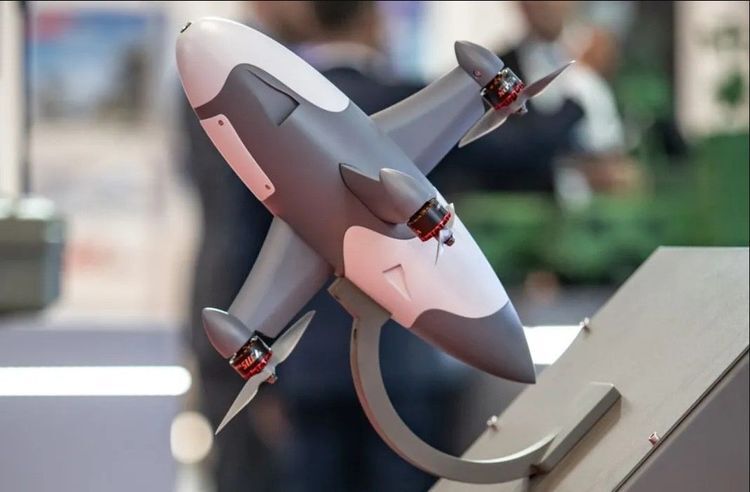TheFool
- 5 Posts
- 58 Comments

 22·1 month ago
22·1 month agoNot something I expected to look up today Context

 10·1 month ago
10·1 month agoGanzer Artikel
MILITÄRTECHNIK
Polnisches Unternehmen stellt die autonome Anti-Drohnen-Drohne vor
Ganze Schwärme billiger Drohnen sollen russische Angriffe aus der Luft abwehren. Das System soll aber auch im zivilen Bereich zum Einsatz kommen
24. September 2024, 12:17

Die neue Drohne verfügt über keinen Sprengkopf und verlässt sich rein auf die kinetische Energie des Einschlags.
APS
Es war wohl nur eine Frage der Zeit, bis es so weit kommt: Das polnische Sicherheitsunternehmen Advanced Protection Systems (APS) hat eine eigene Drohne zur Drohnenabwehr entwickelt. Sie soll die oft improvisierten Methoden ablösen, die im Ukrainekrieg zur Abwehr russischer Drohnen verwendet werden.
Das Unternehmen hat auf einer Waffenmesse im polnischen Kielce die neueste Entwicklung im Bereich der Drohnenabwehr vorgestellt: Ein tropfenförmiges Minifluggerät mit vier Rotoren soll gegnerische Drohnen automatisch erfassen und vom Himmel holen.
Autonom und unbewaffnet
Über einen Sprengkopf verfügt die neue Drohne nicht, sie lenkt sich selbst direkt ins Ziel. Die Energie des Aufpralls soll ausreichen, die feindlichen Fluggeräte vom Himmel zu holen. Das wiederum soll laut den Angaben von APS die Kosten drücken und die Abfangdrohne deutlich billiger machen als bisherige Systeme.
Da die Drohne quasi unbewaffnet ist, soll sie auch im zivilen Bereich eingesetzt werden und könnte etwa den Luftraum kritischer Infrastruktur wie um Kraftwerke oder Flughäfen sichern, wie Defence Blog berichtet.
Laut Maciej Klemm, Mitgründer und CEO von APS, nutzen die neuen Abfangdrohnen maschinelles Lernen. Ein hohes Maß an Autonomie soll die menschlichen Bedienmannschaften entlasten. Wie genau die Abfangdrohnen ihr Ziel finden, ist nicht bekannt. Laut Angaben des Unternehmens kommen Radarsysteme und Videotracking zum Einsatz. Jedenfalls sollen die Abfangdrohnen in der Lage sein, feindliche Drohnen autonom anzugreifen und zu zerstören. Sie können auch in Gruppen operieren und miteinander kommunizieren und sich selbst Ziele zuweisen. Damit sollen ganze Drohnengruppen in der Lage sein, mehrere feindliche Luftfahrzeuge gleichzeitig zu neutralisieren.
Ein Anti-Drohnen-Netzwerk
Die Abfangdrohne ist Teil eines Drohnenabwehrsystems namens Skyctrl. Dieses setzt sich aus Bodenstationen wie modernen MIMO-Radargeräten, Kameras und WLAN-Sensoren zusammen. Dazu kommen die “Neutralisierungswerkzeuge” wie eben die Abfangdrohne und eine Befehls- und Kontrollsoftware. Optional sind auch Bodenstationen integrierbar, die ihrerseits feindliche Drohnen stören sollen. Das System soll selbstständig unterscheiden können, ob es sich um einen harmlosen Vogel oder um eine feindliche Drohne handelt.
Skyctrl ist aktuell bereits in der Ukraine im Einsatz. Laut eigenen Angaben hat sich das System dort bewährt. In den Golfstaaten wird das System zum Schutz von Kraftwerken, Raffinerien und Telekommunikationsnetzen eingesetzt. Darüber hinaus sollen mehrere Nato-Staaten am neuen Drohnenabwehrsystem interessiert sein. Das polnische Militär gehört zu den ersten Nutzern der Technologie.
Neben der Abfangdrohne verfügt das Skyctrl-System aber auch über Neutralisierungswerkzeuge, die man eher nicht in zivilen Händen finden wird. So kann das System auch kleinkalibrige Waffen steuern. Die flexible Architektur des Systems soll auch Maschinengewehre und Laserwaffen in Skyctrl integrieren können.
Improvisierte Abwehr
Ob und wie sich Systeme wie Skyctrl bewährt haben, ist natürlich nicht unabhängig überprüfbar. Jedoch ist schon seit einiger Zeit eine deutliche Professionalisierung des Drohnenkriegs in der Ukraine erkennbar und die bislang eher improvisiert wirkenden Abwehrmaßnahmen werden durch immer modernere Waffensysteme ersetzt.
Im Juli 2024 wurde ein Video veröffentlicht, das zeigt, wie eine ukrainische Drohne, die lediglich mit einem Stock bewaffnet war, mehrere gezielte Angriffe auf eine russische Aufklärungsdrohne des Typs ZALA 421-16E ausführte. Durch diese “Stockhiebe” wurde das Triebwerk der russischen Drohne beschädigt, was letztlich zum Absturz des russischen Luftfahrzeugs führte. Auch die Drohnenabwehr selbst ist aktuell oft noch improvisiert. So sind die russischen Schildkrötenpanzer häufig neben ihrer Rolle als improvisierte Durchbruchspanzer und Mannschaftstransporter auch als mobile Störsender konzipiert – mit oft zweifelhaftem Erfolg.
Die ukrainischen Bedienmannschaften von Drohnen sind häufig das Primärziel von russischer Artillerie oder anderen Drohnen. Jedenfalls steckt hinter vermeintlich simplen Aufklärungsflügen ein enormer Sicherheits- und Logistikaufwand. Jüngst gingen Videos um die Welt, die ukrainische Drohnen zeigen, wie sie Thermit über russischen Stellungen abwerfen und auf einem großen Gebiet unlöschbare Flammen verbreiten. (pez, 24.9.2024)

 36·2 months ago
36·2 months agosigh - Days without thinking about her: 0

 4·2 months ago
4·2 months agoTap for Article
Norway’s weak currency presents a mystery
The country’s economy is thriving yet the krone is becoming less and less valuable. What’s going on?

photograph: alamy
Sep 12th 2024
Norway’s gdp per person is $94,600, some 11% higher than America’s. The country’s unemployment rate is 2%. Growth, though slowing, has been higher than the rest of Europe’s in recent years. And the Norwegian sovereign-wealth fund, capitalised with oil revenues, is now worth over $300,000 per inhabitant.

chart: the economist
What could be better? Answer: the currency. Norwegians are fretting about the krone, which since the end of 2020 has fallen by 8% against a trade-weighted basket of currencies and flirted with all-time lows against the dollar and the euro, following a decade of slower-paced weakening (see chart). In a country that imports almost all its consumer goods, this has added to inflationary pressure. Norges Bank, Norway’s central bank, is confused as to how the country’s economy can be doing so well and its currency so poorly. An official currency commission may follow.
One commonly cited explanation for the fall in value is a lower oil price. Although this may account for some weakness, it fails to explain why the krone did not rebound along with energy prices in 2021-22. Instead, it fell in 2022 even as oil prices surged. Something else is at play.
Analysts at Apollo Asset Management look to interest-rate differentials. As the Federal Reserve raised rates aggressively in 2022-23, the attractiveness of holding dollars rather than krone rose. Norges Bank, responding to the currency’s weakness, seems set to hold rates at 4.5% for the rest of this year, even as the Fed cuts. But this does not tell the whole story either, since the krone has weakened against lots of currencies, including the euro, with which interest rates diverged much less.
Perhaps it is freak pricing. Low trading volumes mean that anomalies may persist, as big investors will be reluctant to enter the market, given that large interventions will interfere with prices. The Bank for International Settlements, a central-banking club, puts krone turnover at just $125bn a day, against $2.3trn for the euro.
A final possibility will be the most alarming to Norwegians. The krone could still be overvalued, with its long march down being a return to normality after the country became a safe haven from the economic turmoil that hit Europe a decade ago. The Economist’s Big Mac index notes that a burger was priced at nkr74 in Norway against $5.69 in America as of June, implying an exchange of nkr13 to the dollar compared with the market rate of nkr11. A further fall would be good news for tourists in Oslo, who would no longer be quite so shocked by the prices. It would be less welcome for Norwegian consumers.
For more expert analysis of the biggest stories in economics, finance and markets, sign up to Money Talks, our weekly subscriber-only newsletter.
This article appeared in the Finance & economics section of the print edition under the headline “Nordic noir”

 191·2 months ago
191·2 months agoTap for Golem Article
Mozilla baut Stellen ab und fokussiert sich neu
Kommt die Wende bei Mozilla? Unter der neuen Chefin Laura Chambers startet Mozilla eine umfassende Reorganisation.
Artikelveröffentlicht am 14. Februar 2024, 7:39 Uhr, Andreas Fischer

Für Firefox könnten wieder neue Zeiten anbrechen.(Bild: KI-generiert durch Bing Image Creator/Dall-E)
Keine Woche nachdem die langjährige Mozilla-Chefin Mitchell Baker ihren Wechsel vom CEO-Posten auf den der Executive Chairwoman der Mozilla Foundation bekannt gegeben hat, baut das Unternehmen 60 weitere Stellen beziehungsweise etwa fünf Prozent der Belegschaft ab. 2020 verloren bereits 250 Mitarbeiter ihren Job bei dem Firefox-Anbieter.
Der erneute Stellenabbau betrifft laut Bloomberg vor allem Mitarbeiter in der Produktentwicklung. Man wolle sich in Zukunft mehr auf Bereiche wie Firefox Mobile konzentrieren, in denen man die größten Erfolgschancen sehe, kündigte Mozilla an.
Auf der anderen Seite werde man Investitionen in Produkte wie VPN, Relay sowie einen Dienst reduzieren, mit dem Anwender bei Datenbrokern über sie gespeicherte Daten löschen lassen können. Darüber hinaus will Mozilla seine 3D-Umgebung Hubs abschalten und weniger Aufwand bei seiner Mastodon-Instanz mozilla.social betreiben.
KI und Firefox im Fokus
Techcrunch veröffentlichte zudem ein internes Memorandum, in dem Mozilla ankündigte, sich künftig unter anderem mehr auf “vertrauenswürdige KI für Firefox” zu konzentrieren. Dazu werde man die Teams zusammenfassen, die sich bislang mit Pocket, Inhalten und KI beschäftigt hätten.
Die Umstrukturierung erfolgt kurz nachdem das Unternehmen Laura Chambers zur Interims-CEO ernannt hatte. Die Australierin nannte als eine ihrer wichtigsten Aufgaben eigentlich die Suche nach einem neuen Chef für den Firefox-Anbieter und nicht eine Reorganisation.
Die Änderungen deuten nach Ansicht von Techcrunch aber darauf hin, dass sich Mozilla wieder stärker auf sein Kernprodukt – den Browser Firefox – konzentrieren könnte. In der Vergangenheit brachte die Organisation zahlreiche neue Produkte heraus und vernachlässigte Firefox. Wohl auch deswegen verlor der früher sehr beliebte Browser immer mehr Marktanteile.
Tap for Bloomberg Article
Firefox Maker Mozilla Is Cutting 60 Jobs After Naming New CEO
By Mark Gurman
February 13, 2024 at 7:16 PM UTC
Mozilla Corp., the maker of web browser Firefox, is cutting about 60 jobs as part of a shake-up under a new chief executive officer.
Mozilla said that the move affects about 5% of its workforce and that the cuts were primarily in the product development organization. The company informed employees of the decision on Tuesday.
“We’re scaling back investment in some product areas in order to focus on areas that we feel have the greatest chance of success,” Mozilla said in a statement. “We intend to re-prioritize resources against products like Firefox Mobile, where there’s a significant opportunity to grow and establish a better model for the industry.”
The move comes a week after the company named Laura Chambers as its CEO. She’s a former Airbnb Inc. and eBay Inc. executive who joined Mozilla’s board three years ago. Mitchell Baker, Mozilla’s longtime chief, stepped down to become the company’s executive chairman.
Mozilla last cut a significant number of jobs four years ago at the height of the Covid-19 pandemic. The not-for-profit company, which competes with Alphabet Inc.’s Google Chrome, Apple Inc.’s Safari and Microsoft Corp.’s Edge, has been grappling with sliding market share of its Firefox web browser in recent years.
In addition to Firefox, Mozilla’s products include email software Thunderbird and article-saving app Pocket.
The move comes after a string of tech layoffs, with more than 32,000 jobs lost in the industry so far this year. Several major tech companies have made cuts in recent weeks, including Amazon.com Inc. and Snap Inc.
— With assistance from Jackie Davalos

 273·3 months ago
273·3 months agoI really don’t get why I should use anything else than dd

 19·3 months ago
19·3 months agoHands down the best is FairEmail

 6·3 months ago
6·3 months agoPoland Leverages China’s Rail Link in Europe to Rein In Belarus
- Warsaw has struggled with migration crisis on Belarus border
- Poland uses key railway route into the EU to pressure China
By Natalia Ojewska, Aliaksandr Kudrytski, and Colum Murphy
July 24, 2024 at 5:02 AM UTC
Poland has threatened to choke off a key Chinese rail export route to the European Union in a diplomatic gambit to slow escalating the migration crisis on its eastern border.
President Andrzej Duda used his state visit in Beijing in late June to link the issue of migration and freight transit on the Belarusian border, according to people briefed on the talks. The number of irregular crossings from Belarus into Poland has dropped significantly since.
Alexander Lukashenko, the authoritarian leader of Belarus, has spent the last three years trying to stir up a migration emergency on his country’s 400 kilometer (250 mile) frontier with Poland. Tensions escalated in May when a Polish border guard was attacked and killed by a migrant, after which the government in Warsaw pledged to spend around $2.5 billion to fortify the area.
It also found a diplomatic pressure point. As Russia’s invasion of Ukraine shuttered trade routes, Belarus has emerged as the sole railway link for Chinese goods heading to the EU with the volume of containers increasing by 89% in the first quarter of 2024, according to the Eurasian Rail Alliance.
Limited Border Traffic May Hinder EU Imports From China
Poland keeps only three checkpoints with Belarus open
Lukashenko welcomed the jump in Chinese rail transit, eager to offset Belarus’ near-total dependence on Russia for cheap energy and loans.
On July 2, after Duda had returned from Beijing, Poland signaled that it would effectively shut rail transit through the Malaszewicze checkpoint on the Belarus border for 33 hours by slowing security and customs checks.
Poland’s leveraging of freight transit in discussions with China “could be a factor” in the lower numbers of border crossings since Duda’s visit, Foreign Minister Radoslaw Sikorski told Bloomberg. “We are still very angry about the killing of our soldier on the border,” he said.
Leveraging China
Attempts to breach Poland’s border have ebbed and flowed in recent years, but began to rise sharply in the weeks before European parliamentary elections in June. Polish Prime Minister Donald Tusk said the migrants were predominantly from Yemen, Somalia, Afghanistan, Syria and Iran and accused Belarus and Russia of weaponizing migration.
The Polish president’s trip to China caught Lukashenko’s attention. In a speech on July 2, the Belarusian leader said that Duda “asked Xi Jinping to influence Lukashenko and Putin so that they would end migration.”
The Chinese Foreign Ministry said in a reply to July 11 questions from Bloomberg News that Beijing “hopes that relevant parties can properly resolve differences through dialog” and “ensure the security and smoothness of international logistics channels.”
Irregular border crossings from Belarus have plummeted by 70% since early June, Interior Minister Tomasz Siemoniak told public broadcaster TVP Info on Tuesday. More than one hundred such cases were reported by the Polish border guards on June 27, the last day of Duda’s state visit.
Even if a tiny part of China’s exports to the EU go via Belarus, the shipping crisis on the Red Sea and its consequences for maritime trade mean that Eurasian rail links are enjoying a renaissance, said Konrad Poplawski from the Centre for Eastern Studies, a Warsaw-based think-tank.
Warsaw’s so-far successful leverage of a strategic vulnerability against China can serve as a lesson for policymakers. Beijing, which Poplawski said is the EU’s “trade partner but also a competitor and systemic rival,” can change tack if the bloc is “ready to bear economic costs” when its core interests are at stake.
— With assistance from Maxim Edwards and Slav Okov
Läuft da Ärger in Terroristenstadt von Zimbelmann im Hintergrund?
Found the issue: the videos you posted are using the av1 codec, and I am on iOS
I can browse 9gag no problem
Voyager but it won’t open in my browser either. Just tried VLC it works there so maybe it’s a codec issue









What getting no couch does to a mf